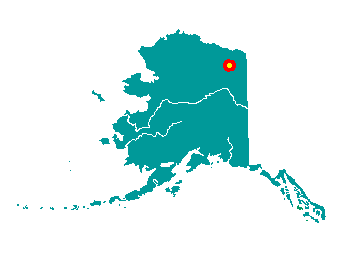|
Arctic Village
Arctic Village is located in the Barrow Recording District, on the east fork of the Chandalar
River, 100 miles north of Fort Yukon and 290 miles north of Fairbanks. The
area encompasses 61.7 sq. miles of land and 8.1 sq. miles of water. Arctic
Village has a continental subarctic climate. Winters are long and harsh, summers
are
 short but warm. The average high temperature during July ranges from 65 to
72; the average low temperature during January is well below zero. Extended
periods of -50 to -60 are common. Extreme temperatures have been measured from
-70 to 90. Precipitation averages 9 inches, with an annual snowfall of 52.8
inches. short but warm. The average high temperature during July ranges from 65 to
72; the average low temperature during January is well below zero. Extended
periods of -50 to -60 are common. Extreme temperatures have been measured from
-70 to 90. Precipitation averages 9 inches, with an annual snowfall of 52.8
inches.
Until the 1950s, the Neets'aii Gwichin ("residents of the north side") lived
a highly nomadic life. They traditionally used seasonal camps and semi-permanent
settlements, such as Arctic Village, Christian, Venetie and Sheenjak in pursuit
of fish and game. They traded with Inupiat Eskimos on the Arctic coast. There is
archaeological evidence that the Arctic Village area was populated as early as
4,500 BC.
Accessible only by air or river, Arctic Village is about 200
miles north of Fairbanks in the heart of the Arctic National Wildlife Refuge.
The village has 152 residents (as of the 2000 census) who subsist through
hunting, trapping and fishing. Then more permanent structures were built, a
runway was carved alongside the river bed, and the outside world became more
accessible.
 In 1863, Archdeacon McDonald of Fort Yukon observed that the Chandalar
Kutchin were important providers of caribou meat for the residents of Ft. Yukon.
Reverend Albert Tritt, a Neets'aii Gwich'in born in 1880, wrote that his people
led a nomadic life, traveling to the Arctic coast, Rampart, Old Crow, the Coleen
River and Fort Yukon in the 1880s and 1890s. With the advent of firearms in the
early 1900s, family groups began to gather more permanently at several
locations; there was no longer a need to disperse into small groups to hunt
caribou. The first permanent resident at the present village site was Chief
Christian in 1909. In 1943, the Venetie Indian Reservation was established, due
to the efforts of several area villagers to protect their land for subsistence
use. The first school was built in 1959. When the Alaska Native Claims
Settlement Act (ANCSA) was passed in 1971, Venetie and Arctic Village opted for
title to the 1.8 million acres of land in the former Reservation. Residents
continue to use the community as a base of operations from which they pursue
seasonal subsistence activities. In 1863, Archdeacon McDonald of Fort Yukon observed that the Chandalar
Kutchin were important providers of caribou meat for the residents of Ft. Yukon.
Reverend Albert Tritt, a Neets'aii Gwich'in born in 1880, wrote that his people
led a nomadic life, traveling to the Arctic coast, Rampart, Old Crow, the Coleen
River and Fort Yukon in the 1880s and 1890s. With the advent of firearms in the
early 1900s, family groups began to gather more permanently at several
locations; there was no longer a need to disperse into small groups to hunt
caribou. The first permanent resident at the present village site was Chief
Christian in 1909. In 1943, the Venetie Indian Reservation was established, due
to the efforts of several area villagers to protect their land for subsistence
use. The first school was built in 1959. When the Alaska Native Claims
Settlement Act (ANCSA) was passed in 1971, Venetie and Arctic Village opted for
title to the 1.8 million acres of land in the former Reservation. Residents
continue to use the community as a base of operations from which they pursue
seasonal subsistence activities.
A federally recognized tribe is located in the community -- the Arctic
Village Traditional Council. 92.1% of the population are Alaska Native or part
Native. The Neets'aii Gwich'in of Arctic Village lead a subsistence-based
lifestyle. The village council is combined with Venetie.

Village Council - Arctic Village
Traditional Council, P.O. Box 22059, Arctic Village, AK 99722, Phone
907-587-5328
|